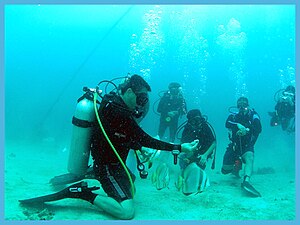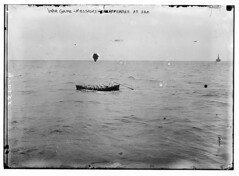 Image via Wikipedia
Image via Wikipedia
If
PADI dive instructor “Virginia from Virginia” Hatter’s experience is any indication, there has been a “surge,” no pun intended, in
SCUBA diving interest on the
part of women.
When she started instructing in San Diego, her male students outnumbered their female counterparts by a ratio as high as 80:20. Now, it has become equal, if not more women, maybe as high as 60 to 70 per cent female, she says.
“I do not advertise. Almost 100 per cent of my students are referrals,” says Virginia, who only learned to dive herself in 2004 and quickly progressed from PADI Open Water Diver certification to several specialized disciplines, PADI Master SCUBA Diver, PADI Assistant Instructor, PADI Open Water Instructor and PADI Master SCUBA Diver Trainer.
In her case, female students recommending her course to their friends is a factor in changing the male-female ratio so dramatically. But it’s also a sport that is as suited to one sex as the other.
“Everyone loves the ocean, exploring wrecks, canyons, reefs and all different types of diving.”
Growing up in Virginia (hence the nickname “Virginia from VA”), she had learned to love a variety of water sports, from small time sailing to waterskiing, jet skiing,
surfing and swimming.
“I’m a water person anyway,” Virginia says, so she welcomed the challenge and opportunity when her staff at a sports retail store she managed urged her to sign up for PADI Open Water Diver lessons the store was offering. “I loved it from the first breath I took underwater in the pool. Little did I know it would change my entire life.”
Being a stressed out HR manager in Virginia wearing dress suits and paying to park, turned into her passion for “changing the lives of others for the better through SCUBA diving instruction.” She adds that “the only difference is my panty hose are now
seven-mm thick.”
Virginia had moved to San Diego by the time she took up SCUBA diving and instructing has become a full-time job for her. She has a waiting list of students.
She prefers to work as an independent so she can control the number of students in her classes and does not press her students to finish in a prescribed time. “There are no make-up fees for classes missed, nor will I promise a certification date.”
“I do not believe in large classes,” says Virginia, who never teaches more than four students in the water at once, and usually instructs private or semi-private classes. “I don’t want to be the biggest. I strive to be the safest.”
It has been a little slow this year due to problems that affected all dive operations in the San Diego area. They include high surf, red tide, strong currents and low visibility.
“I do not take students in unfavourable conditions. Instructing students to dive in these circumstances and conditions is simply not safe. Diving is already a little intimidating as it is. Safety must come first, then education, followed by fun.”
Virginia also suffered two sting ray hits that kept her out of the water for awhile. The second one was more painful. A large number of small, aggressive sting rays had congregated close to shore off San Diego for four or five days and there were more than 100 hits, including hers.
Virginia says she doesn’t know if her female students are more comfortable with a woman instructor than a man, but that wasn’t the case for her. Her instructors were all men and she called them “the best of the best.” She never experienced any male chauvinist attitude among instructors who taught her or among those who are now her competition. “Most are men for whom I have the highest regard.”
In fact, she adds, when she couldn’t instruct while her foot recovered from the sting ray hit, a male instructor who was her competitor helped her out by finishing the course for one of her students whose completion was time sensitive. Another female instructor helped with the same student, only proving what a bond SCUBA instructors develop, no matter who they instruct for. This student is now becoming a commercial diver in hopes to aid with repair efforts in the Gulf of Mexico on other oil rigs. “We’re all on the same team.”
Virginia credits SCUBA Diver Girls for playing an “awesome role” role in attracting women to the sport. She once got eight women together to dive in hopes it would lead to something better “but it just fizzled out. So when Scuba Diver Girls started, I said ‘way to go, girls.’
SCUBA Diver Girls are in a class of their own, they rock.”
The next step is to involve the entire family in the sport more often. Virginia has certified children as young as 10 as PADI JR Open Water Divers. One of them who took her certification class went on to dive on just about every continent. The child’s parents took her course, too, because the whole family was going on a world tour “home schooling” their daughter.
Another young diver of hers is currently working on her JR Advanced Open Water Diver with her father in tow and plans to complete PADI JR RESCUE Diver, as well.
Could family diving become the next trend?
Kathy Dowsett
www.kirkscubagear.com










